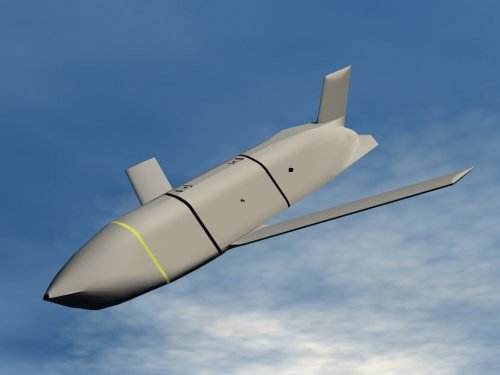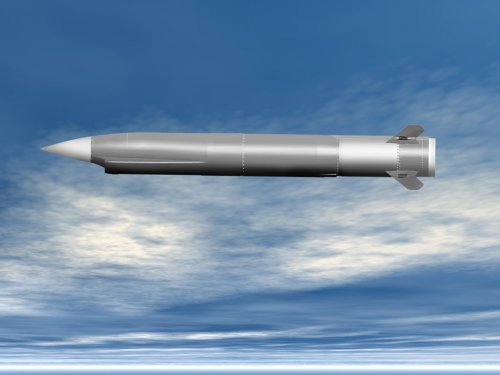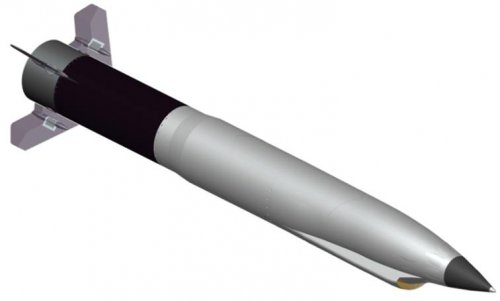May 2009
Interview with Rob McHenry, Program Manager, Tactical Technology Office (6/09)
Jan Walker: Today, we're here with Rob McHenry, a program manager in the Tactical Technology Office, and the first thing I guess I'll start with is you're going to shortly be kicking off your Long-Range Anti Ship Missile demonstration program, or LRASM, as we fondly call it.
Tell us a little bit about what LRASM is and what that program's goal is.
Rob: OK, Jan. LRASM is an effort to place the US Navy in a dominant position on the high seas.
So, within the program, we've defined a set of capabilities to help assure that. The first is long range. We want US Navy cruisers and destroyers to be able to stand off from outside of potential adversaries’ direct counter fire range, and be able to safely, from that position, be able to engage and destroy high value targets they may be engaging against. So, the missile has a range requirement that's well beyond potential adversary ranges that we may have to face.
Once the missile flies that far, it has a requirement to be able to independently detect and validate the target that it was shot at.
Once it finds that target, then it has to be able to penetrate the air defenses. The standard of maritime integrated air defenses has risen dramatically over the past few years. There are other countries working very hard on their capabilities, to be able to defend a surface force of ships at sea.
The LRASM missile is going to use a special set of capabilities to be able to survivably penetrate through those defensive layers and be able to reach the target it was shot at. And then finally, once it gets to that target, it has to have a lethal capability to make a difference once it gets there.
Jan: So this is a capability that the Navy currently doesn't have?
Rob: The Navy currently has a credible anti ship missile capability.
People talk about sometimes the balance between the left side of the kill chain, which is sort of the sensors and networks that target a weapon, and the right side, which is the weapon itself that actually goes out and prosecutes a target.
Right now, all the weapons that we use are dependent on that left side. They need a lot of things to feed and help them. LRASM is a dramatically different approach in that we've cut off the entire left side.
It's a new level of capability organic to the weapon itself, so that without the precise target cueing from all these other systems and networks to provide it and feed it to the weapon, the weapon itself can go out to the target area and complete the mission.
Jan: You've probably given us some clues as to what your key technical challenges are. I assume the sensor is one of them.
Rob: That's exactly right. Starting from the chain of events as this missile goes out and does its job, there's a set of technical challenges associated with integrating it into the ship launch systems. It's called the vertical launch system, that's on US Navy destroyers and cruisers. And so this missile... it has to be packaged such that it can safely be operated from those Navy platforms. [Other challenges include] the propulsion systems to be able to achieve these very long-range objectives, and also some interesting flight profiles to improve their survivability. So, there's a propulsion set of technologies that have to be developed and matured.
But, you're right, the seeker is one of the hardest areas. Basically, we're packaging all the capability of some very sophisticated surveillance aircraft and some other platforms onto this very small missile, and doing it to a similar level of capability.
And so developing those sensors, integrating them together, and then being able to have the automated processing on board the weapon so that, in real time, it can make sense out of all that sensor data that it's getting and make the tactical decisions it needs to hit the target.
Jan: It sounds like you're pretty excited to get this thing started. Just so people know when to start looking for more information.
Rob: Yes, we're in the final process of getting the awards formalized, and we expect within the next 60 days to have those awards made, and be moving forward.
Jan: That sounds great. I wanted to find out a little bit about your background, and how you came to be at DARPA.
Rob: I have a Navy background. I was a submarine officer in the Navy, and had a very fortunate opportunity to go work for the Chief of Naval Operations in the OPNAV staff, the Navy staff here in Washington, DC. During that time, when I was in uniform in the Navy, I actually had the opportunity to come over to DARPA and spend some time here. DARPA has a program called the Service Chiefs' Intern Program, where the DARPA director invites the Chiefs of Staff of each of the Services to send officers over to sort of be dunked into the DARPA process, and get some understanding of what DARPA is, and how it helps the Department of Defense.
So, I was actually Service Chief Intern number one. I was the very first prototype of that thought, that then director Tony Tether had. Admiral Clark asked me, from his staff, "Come over and see what DARPA is about."
So, from that very early time I kind of got exposed to what DARPA was. I was just amazed at DARPA's ability to explore different challenging technical areas, to move quickly without some of the burdens that [in the] the rest of the Department of Defense seems to slow [things] down a little bit.
I've often said that, in other jobs, it takes five minutes to see what the real challenge is, but then I'll spend a year working through politics and finance and trying to execute a solution to go fix the problem.
DARPA is kind of the opposite of that. You may spend a year thinking through an idea, and polishing and crafting the right program, but once you have that idea right, it takes five minutes to go to the director, get funding, and go move forward and execute the program.
It's unprecedented anywhere else in the federal government to be able to work like that.
Jan: So, when you came to DARPA, did you have any particular goals or things that you wanted to accomplish when you were here?
Rob: Yes, coming from my Navy background, I obviously tend to think in terms of naval operations and systems to support the Navy. In addition to programs like LRASM, [I’m] looking at different ways to execute similar approaches to weapons systems, and how to execute strike and attack missions. One of my other big areas of interest is in large scale, unmanned surface vehicles. The Navy, to date, has only explored a very small corner of what I think the potential is for unmanned surface vehicles to change the way that we conduct naval operations. Everything from different missions, different technologies to make unmanned surface vehicles, ranging from the kinds of small things we think about as unmanned surface vehicles today up to large scale unmanned ships someday. I'm trying to put together a portfolio of programs to explore that space.
Jan: That sounds really interesting. Thank you so much for coming by today.
Rob: Thank you, Jan.




